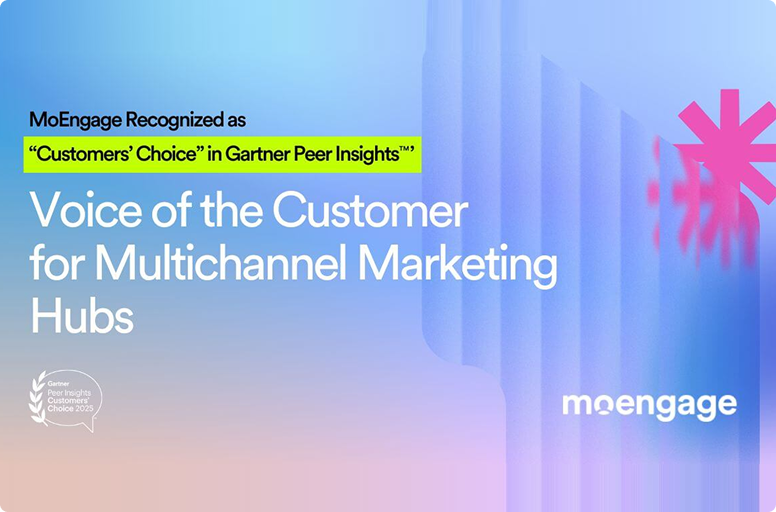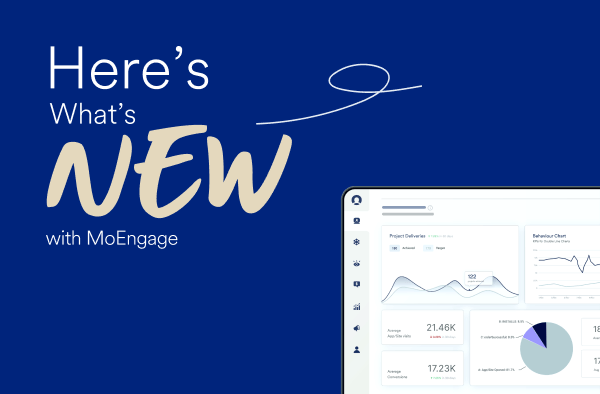Personalized and Marketing Automation Lessons with Bukalapak’s Muhammad Juliansyah [Marketer Spotlight]
![Personalized and Marketing Automation Lessons with Bukalapak’s Muhammad Juliansyah [Marketer Spotlight]](https://www.moengage.com/wp-content/uploads/2019/04/Marketer-Spotlight_01-2-1.png)
Reading Time: 7 minutes
Editor’s note: We caught up with Muhammad Juliansyah Pratama, the e-mail and push notification lead for Bukalapak, one of Indonesia’s biggest e-commerce platforms, to know how Bukalapak is using marketing automation to improve their marketing campaigns and make it more personalized.
Marketer Spotlight series covers opinions and advice from marketing leaders and influencers on the industry challenges, trends, and best practices.
MoEngage: Welcome to MoEngage Marketer Spotlight, Julian. Tell us something about yourself and your company.
After starting my career in a small digital marketing agency, I joined the digital marketing team of Bukalapak. Bukalapak is one of Indonesia’s biggest e-commerce platforms. It started as a marketplace but has quickly expanded to offer a wide range of products and services such as virtual products (from data plan to event tickets), fintech (investment products, gold, business loan, etc.), and Online to Offline (O2O) services through Mitra Bukalapak. I was initially handling the paid digital platforms and was also involved in developing a subscription-based, automated Google shopping ads platforms for our sellers. Now I manage the emails and push notifications marketing for Bukalapak.
In today’s day and age, marketers have so many different tools and channels to focus on. What is the role of automation in such a scenario?
Today we have so many tools, and channels to nurture our leads through the purchase funnel and so many channels to focus upon, that managing and optimizing them becomes a huge challenge. Sometimes you may get overwhelmed while segmenting the audience, defining what to send, crafting a compelling message, and executing it. Automation helps in a lot of ways by heavy lifting the processes, sending the relevant messages to each user at the right time and scale. It also helps in optimizing the campaigns with the help of machine learning tools. Automation helps in making the campaigns more efficient and generate better results. It also gives you time to focus on strategies, budget management, and other activities.

Speaking about the benefits of automation takes us to the next question. Based on your experience in handling various marketing channels at Bukalapak and your previous roles, which parts of marketing efforts/processes can be automated?
You can automate many processes including audience segmentation, nurturing leads through the purchase funnel (lead generation, customer acquisition, customer retention, re-engaging churned customers, cross-selling, retargeting, etc.), and campaign management & optimization.
Here are a few use cases on how automation can optimize these processes:
- Audience segmentation: You can use automated audience segmentation such as Facebook Custom Audience to set your segmentation based on specific event triggers & attributes and update your audience list every time your users fit the rules.
- Customer acquisition & retention: You can use dynamic product ads for retargeting. You can either configure the ad to target leads automatically or target customers who have browsed products your site or app but haven’t converted yet by showing them relevant products to drive conversions.
- Re-engaging churned customers: Push notifications are an excellent way to re-engage churned customers or prevent them from leaving the app. For example, you can set triggers to send automatic push notifications to users who have not engaged with your app or website for ‘x’ number of days to drive engagement.
What are the specific benefits of marketing automation for growing online commerce businesses?
Automation helps us to execute our marketing campaigns more efficiently by reducing manual efforts and enabling us to scale. It has helped us to make the campaigns more engaging by delivering tailored messages to the right audience at the right time by leveraging the customer data.
How does Bukalapak leverage marketing automation platform like MoEngage? Could you share some examples and results that you’ve achieved?
We use MoEngage to send emails and push notifications to our clients. It has helped us in automating activities such as sending messages in recipients’ time zone, utilizing dynamic values in our messages, and delivering a tailored message based on customer behavior to drive our metrics.
We use MoEngage’s Sherpa and its A/B testing features for our campaigns. The A/B testing feature provides us with great control over dividing audience groups, creating different variants and components to test, and provides us with accurate analytics. Sherpa optimization helps us to determine which variant will drive conversions so we can prioritize it over other options.
For example, we used a flow campaign to promote one of our gamification features. We created several campaigns for different segments based on customer behavior (based on certain trigger events). Whenever a use matched the campaign trigger rules, they were sent a tailored message based on their behavior, asking them to play the “game.” These campaigns showed higher engagement rate as compared to our regular campaigns. The CTR increased by up to 2.5x, while the CVR was 80% higher than some of our campaigns.
We look forward to driving more automated marketing campaigns by sending push notifications and emails based on customer purchase pattern behavior to prevent churning of customers and to improve the retention rate for certain virtual products.
Another new buzzword doing the rounds is personalization. Would you agree, Julian, that personalization is an essential aspect of a brand’s marketing strategy today?
Personalization is critical. Research by Epsilon shows that 80% of the consumers are more likely to do business with a company that offers personalized experiences. Personalization leads to a win-win situation for both customers and marketers. Customers get relevant and engaging content, and marketers can improve their conversion rates and ROI through better engagement.
What are the important elements to consider while implementing marketing automation?

I think there are three things you need to implement for successful marketing automation – user attributes, events, and event attributes. You have to track them all so that all your use-cases are covered and you can make effective marketing automation campaigns.
From those user attributes, events, and event attributes, you will be able to create segmentation, use dynamic message, define what event and attributes will act as triggers to send that message, and determine which events will be regarded as conversion actions so that your marketing campaign can run automatically.
At Bukalapak, we track an array of user attributes, events, & event attributes to cover most of our marketing promos, from the simple ones to the particular ones. Let me give you an example for push notifications campaign.
When a user visits a product page priced >$5 in our app, they will receive a push notifications about a cashback promo with shipping method A. As our objective is to drive transactions with shipping method A, we set up “purchase with shipping method A” as a conversion action. So, when we run the campaign, it will automatically send push notifications to users who fit the trigger rules. This will help us to track real conversions based on the campaign’s objective.
I would recommend evaluating what kind of marketing automation you want to run, define which attributes and events you want to track, and implement them to your marketing automation platform!
Blast Vs. Segmented Vs. Personalized campaigns – How are these different. What benefits does each of these have?
Mass blast, segmented, and personalized has their use-cases, and pros and cons.
- Mass blast campaign: In a mass blast campaign, the message is broadcasted to everyone in your list. The message may not be relevant to everyone and could even annoy some recipients and lead them to unsubscribe from your list. However, it is effective if your focus is to increase reach and raise brand or campaign awareness. A simple use case that I can think of is sending emails to all the users during special occasions such as Ramadan or Christmas.
- Segmented campaign: Segmented campaigns are targeted to specific customer segments that are relevant to your offer. Your segments can be defined based on demography, behavior, and their position in the purchase funnel. You can define your segments loosely or very specifically, but keep in mind that it will affect the audience size. With segmented campaigns, you will be able to craft a more compelling and relevant message based on your target segment needs and preferences. This will help you to engage your users better and reduce the risk of annoying them because they will not be spammed with an irrelevant message.
- Personalized campaigns: In terms of audience segmentation, there is no difference between a segmented campaign and personalized campaign. Both target specific customer segments and leverages upon customer preference and behavior to deliver a relevant message. However, a personalized campaign takes it one step further. It uses dynamic values or components such as addressing customers by their names, sending dynamic product recommendations, delivering different messages based on user’s location (by using tools such as MoEngage’s geofencing) and how long they’ve been there. I believe personalized campaigns deliver the best results due to its high relevancy as compared to the other types.
Can personalization and marketing automation work in tandem? Are there any examples that demonstrate the right mix of personalized marketing automation strategy done effectively? What results can marketers expect from such a combination?
I think personalization works best with automation. You can craft a personalized message for each of your target segments, but it will take days or even months for the campaign to start running. To ramp up the speed of highly personalized campaigns and to use dynamic components, you need automation.
An excellent example of personalized marketing automation is O2’s programmatic campaign. O2 wanted to make their ‘tariff refresh’ TV ad more relevant and engaging for their mobile audience. So the team created used data such as device, and location to tailor their message to their consumers. It helped them to create more than 1,000 versions of the video ad, tailored to the user’s device and location.
The personalized automated ad led to a 128% increase in CTR. The key takeaway here is that by combining personalization and automation in a marketing campaign, you will have less execution workload and higher engagement rate and ROI.
And finally, what is your favorite advice on getting marketing automation and personalization right?
Our core value at Bukalapak is customer obsession. I believe it’s important to be obsessed with your customers. Marketers should leverage upon data to understand the customer’s behavior such as what they like, dislike, and create personalized marketing campaigns using marketing automation. Your customers derive value from the personalized offers and experiences delivered to them. It helps in increasing conversions and growing the business.
Thank you, Julian, for taking out time to share your thoughts on marketing automation. We look forward to seeing some innovative marketing campaigns from Bukalapak in future.
Marketers – Is there someone you’d like us to feature in our spotlight series? What topics would you recommend for our next feature? We invite your recommendations and feedback via the comments section below.













